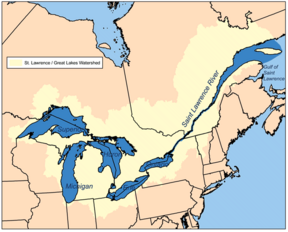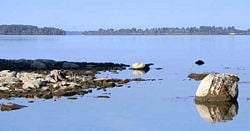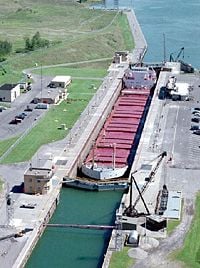Saint Lawrence River
| Saint Lawrence River | |
|---|---|
| | |
| Origin | Lake Ontario |
| Mouth | Gulf of Saint Lawrence/Atlantic Ocean |
| Basin countries | Canada (Ontario, Quebec) United States (Illinois, Indiana, Michigan, Minnesota, New York, Ohio, Pennsylvania, Vermont, Wisconsin) |
| Length | 1,197 km (744 mi) |
| Source elevation | 250 m (820 ft) |
| Avg. discharge | 10,400 m³/s (367,328 cu ft/s) |
| Basin area | 1,030,000 km² (397,683 sq mi) |
The Saint Lawrence River and Seaway System is a large hydrographic system in east-central North America, crossing the interior of the continent for approximaely 2,500 miles (4,000 kilometers). The Saint Lawrence Waterway begins at the North River in the U.S. state of Minnesota, which flows into Lake Superior) with Cabot Strait, finally flowing into the Atlantic Ocean in the extreme east of Canada.
It is the primary drainage of the Great Lakes Basin. The System traverses the Canadian provinces of Quebec and Ontario and forms part of the international boundary between Ontario, Canada, and the U.S. state of New York. It is of vital geographic, hydrologic, and economic importance to both countries.
Overview
Though the Saint Lawrence River itself is slightly less that 750 miles (2,000 km) in length, it is part of a much larger system which begins in the U.S. state of Minnesota, and in its entirety, covers approximately 2,500 miles (4,000 km).
The system can be divided into three main sections:
- the beginning of the system in the Great Lakes region, which consists of narrow river-like sections connecting the lakes themselves.
- the central section, which is considered to be the beginning of the Saint Lawrence River at the outflow of Lake Ontario between the town of Kingston on the north bank, Wolfe Island in mid-stream, and Cape Vincent, New York on the south bank. From this point to the Île d’Orléans, just downstream from the city of Quebec, this section is considered to resemble a more normal river pattern.
- from the Île d’Orléans to the Cabot Strait, between Newfoundland and Nova Scotia, the system again widens, becoming the St. Lawrence estuary. As it passes Anticosti Island it becomes the oval-shaped marine region known as the Gulf of St. Lawrence.
From its furthest headwater is the North River in the Mesabi Range at Hibbing, Minnesota, it runs approximaely 2,500 miles (4,000 kilometers) before it releases into the Atlantic Ocean.
Its drainage area, which includes the Great Lakes and hence the world's largest system of fresh water lakes, has a size of 390,000 square miles (1.03 million sq km). The average discharge at the mouth is 10,400 cubic meters per second (367,000 cu ft/s).
The Saint Lawrence River itself includes Lake Saint-Louis south of Montreal, Lac Saint-François at Salaberry-de-Valleyfield and Lac Saint-Pierre east of Montreal. It surrounds such islands as the Thousand Islands near Kingston, the Island of Montreal, Île Jésus (Laval), Île d'Orléans near Québec City, and Anticosti Island north of the Gaspé. Lake Champlain and the Ottawa, Richelieu, and Saguenay rivers drain into the St. Lawrence.

Geology
The heart of the North American continent is drained through the Saint Lawrence system, which occupies an ancient geologic depression, involving three geologic regions: the Canadian Shield, the Appalachian Mountains, and the intervening sedimentary rock platform.
Toward the end of the Quaternary Period, the glaciers that had occupied the depression since the Pleistocene Ice Age were replaced by the Champlain Sea, which flooded the depression from about 13,000 to 9,500 years ago. A slight uplifting which occurred about 6,000 years ago expelled this arm of the ocean, forming the river course of the St. Lawrence. [1]
Plant and animal life
Plant life along the Saint Lawrence includes coniferous forest, open taiga, deciduous forest, and mixed forest areas. River-linked characteristics include sandbank grasses of the freshwater section and the halophytic (salt-tolerant) plants found from the middle estuary onward.
The river's fish include such species as sturgeon, smelt, and herring. Mammals include the beluga whale; mollusks, the soft-shell clam Mya arenaria, among others. The entire river course experiences a massive migration of bustards, ducks, and geese, which make use of the sandy shores or river reefs as seasonal food sources. [1]
History
The first known European explorer to navigate the St. Lawrence was Jacques Cartier, who sighted the Bay of Chaleur in 1534 and also claimed New France for Francis I. The land was inhabited at the time by the St. Lawrence Iroquoians. He returned to the area the following year. Arriving at the Gulf on St. Lawrence' feast day, he accordingly named it the Gulf of St. Lawrence.[2] The river was also navigated by French explorer Samuel de Champlain.
Until the early 1600s, the French used the name Rivière du Canada to designate the Saint Lawrence upstream to Montreal and the Ottawa River after Montreal. The Saint Lawrence River served as the main route for exploration of the North American interior.
The St. Lawrence was formerly continuously navigable only as far as Montreal because of the virtually impassible Lachine Rapids. The Lachine Canal was the first to allow ships to pass the rapids; the Saint Lawrence Seaway, an extensive system of canals and locks, now permits ocean-going vessels to pass all the way to Lake Superior. The Seaway was officially opened on 26 June 1959 by Queen Elizabeth II (representing Canada) and President Dwight D. Eisenhower (representing the United States of America).
In the late 1970s, the river was the subject of a successful ecological campaign (called "Save the River"), originally responding to planned development by the United States Army Corps of Engineers. The campaign was organized, among others, by Abbie Hoffman, then on the run under the pseudonym of Barry Freed.
Saint Lawrence Seaway
The St. Lawrence Seaway is the common name for a system of canals that permits ocean-going vessels to travel from the Atlantic Ocean to the Great Lakes, as far as Lake Superior. Legally it extends from Montreal to Lake Erie, including the Welland Canal and the Great Lakes Waterway. The seaway is named after the Saint Lawrence River, which it follows from Lake Ontario to the Atlantic Ocean.
Consequences of Construction
To create a navigable channel through the Long Sault rapids and to allow hydroelectric stations to be established immediately upriver from Cornwall, Ontario and Massena, New York, an artificial lake had to be created. Called Lake St. Lawrence, it required the flooding on July 1, 1958 of ten villages in Ontario, now collectively known as "The Lost Villages". There was also inundation on the New York side, but no communities were affected.
The creation of the seaway also led to the introduction of foreign species of aquatic animals, including the sea lamprey and the zebra mussel, into the Great Lakes Basin. These organisms were introduced via ballast water from oceanic vessels.
The seaway provides significant entertainment and recreation such as boating, camping, fishing, and scuba diving. Of particular note is that the seaway provides a number of divable wrecks within recreational scuba limits (shallower than 130 ft.). Surprisingly, the water temperature can be as warm as 70°F with little or no thermocline during the mid to late summer months.
The seaway's opening is often credited with making the Erie Canal obsolete, thus setting off the severe economic decline of several cities in upstate New York
Lock and channel dimensions
The size of vessels that can traverse the seaway is limited by the size of locks. Locks on the St. Lawrence and on the Welland Canal are 766 feet (233.5 m) long, 80 feet (24 m) wide, and 30 feet (9.1 m) deep. The maximum allowed vessel size is slightly smaller: 740 feet (225.6 m) long, 78 feet (23.8 m) wide, and 26 feet (7.9 m) deep; many vessels designed for use on the Great Lakes following the opening of the seaway were built to the maximum size permissible by the locks, known informally as Seaway-Max. Large vessels of the lake freighter fleet are built on the Lakes and cannot travel down the seaway to the ocean. The only lock on the Great Lakes Waterway is 1,200 feet (357 m) long, 110 feet (33.5 m) wide and 32 feet (9.8 m) deep, but the channels are not kept that deep.
Water depth is another obstacle to vessels, particularly in connecting waterways such as the St Lawrence River. The depth in the channels of the seaway is 41 feet (12.5 m) (panamax depth) downstream of Quebec City, 35 feet (10.7 m) between Quebec City and Deschaillons, 37 feet (11.3 m) to Montreal, and 28 feet (8.2 m ) upstream of Montreal. Channels in the Great Lakes Waterway are slightly shallower: 25 to 27 feet (7.62 to 8.2 m). In the late 1990's the seaway has been deepened and widened increasing near panamax sized ship access upstream from the Atlantic ocean to Montreal.
Channel depths and limited lock sizes mean that only 10 percent of ocean-going ships can traverse the entire seaway. Proposals to expand the seaway, dating from as early as the 1960s, have been rejected as too costly, and environmentally and economically unsound. Lower water levels in the Great Lakes have also posed problems for some vessels in recent years.
Earlier canals
In 1862, locks on the St Lawrence allowed transit of vessels 186 feet (57 m) long, 44½ feet (13.6 m) wide, and 9 feet (2.7 m) deep. The Welland Canal at this time allowed transit of vessels 142 feet (43 m) long, 26 feet (7.9 m) wide, and 10 feet (3.0 m) deep. These were generally too small to allow passage of larger ocean-going ships.
Notes
- ↑ 1.0 1.1 Encyclopædia Britannica Online. 2008. Saint Lawrence River and Seaway Retrieved May 27, 2008.
- ↑ William Henry Johnson, French Pathfinders in North America, Project Gutenberg. Retrieved December 21, 2007.
ReferencesISBN links support NWE through referral fees
- CBC Digital Archives. The St Lawrence Seaway: Gateway to the world Retrieved May 27, 2008.
- Encyclopædia Britannica Online. 2008. Saint Lawrence River and Seaway Retrieved May 27, 2008.
- Environment Canada. The St. Lawrence River: Gateway to North America Retrieved May 27, 2008.
- Government of Canada. The Lost Villages Historical Society Retrieved May 27, 2008.
- LexUM. Exchange of Notes, amending 1959 Agreement of Application of Tolls Retrieved May 27, 2008.
- Peace Palace Library. Bibliography on Water Resources and International Law Retrieved May 27, 2008.
- Saint Lawrence Seaway Development Corporation. The Saint Lawrence Seaway Development Corporation Retrieved May 27, 2008.
- The St. Lawrence Seaway Management Corporation. Great Lakes St. Lawrence Seaway System Retrieved May 27, 2008.
- The Ships List. Excerpt from the Illustrated London News, January 11, 1862. Canadian Canals Retrieved May 27, 2008.
- Willoughby, William R. 1961. The St. Lawrence waterway; a study in politics and diplomacy. Madison: University of Wisconsin Press. OCLC 932877
External links
All links Retrieved December 21, 2007.
- St. Lawrence Parks Commission (Ontario)
- Great Lakes St. Lawrence Seaway System
- Safe Passage: Aids to Navigation on the St. Lawrence — Historical essay, illustrated with drawings and photographs
- St. Lawrence River Live Webcam
- International Saint Lawrence River Board of Control
Credits
New World Encyclopedia writers and editors rewrote and completed the Wikipedia article in accordance with New World Encyclopedia standards. This article abides by terms of the Creative Commons CC-by-sa 3.0 License (CC-by-sa), which may be used and disseminated with proper attribution. Credit is due under the terms of this license that can reference both the New World Encyclopedia contributors and the selfless volunteer contributors of the Wikimedia Foundation. To cite this article click here for a list of acceptable citing formats.The history of earlier contributions by wikipedians is accessible to researchers here:
The history of this article since it was imported to New World Encyclopedia:
Note: Some restrictions may apply to use of individual images which are separately licensed.



